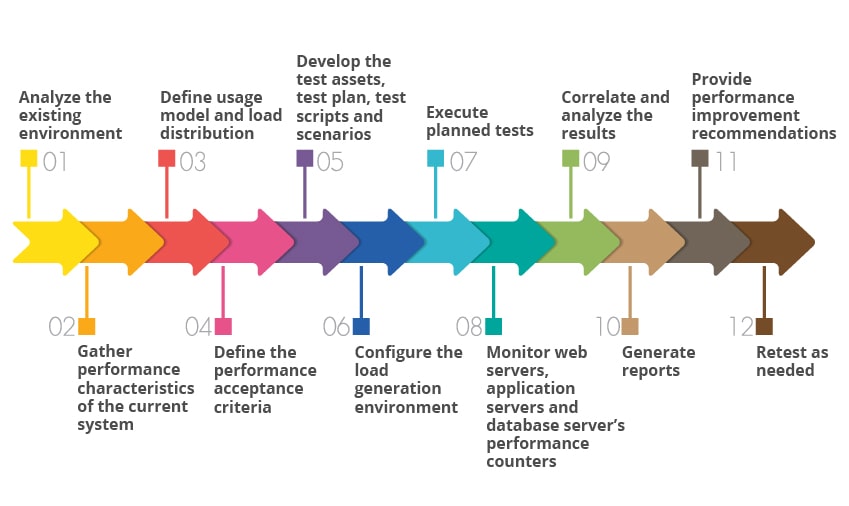Recommended Blogs
Major Performance Testing Challenges and How to Overcome Them

Table of Contents
- What is Performance Testing?
- Why is Performance Testing Essential for Testing Business Websites and Mobile Apps?
- Performance Testing Process in Software Testing
- Performance Testing in DevOps Pipelines
- Role of Machine Learning in Predictive Performance Testing
- Open Source vs Commercial Performance Testing Tools
- What are the Challenges of Performance Testing and How to Overcome Them?
- Performance Testing for Mobile and Web Applications and Key Metrics to Monitor
- Conclusion
Some of the common types of functional testing are Unit, Integration, System, Sanity, Smoke, Interface, Regression, Acceptance testing, etc. Some of the most common Non-functional testing types are Reliability, Endurance, Localization, Recovery, and Performance testing, to name a few.
Out of these testing types, Performance testing is one of the important testing process that plays a critical role by ensuring the software performs stably and seamlessly even under varying load conditions.
What is Performance Testing?
Performance or load testing is an important non-functional type of testing and involves the process by which software or an application is tested to know its current system performance.
This sort of testing checks how your current system performs in terms of responsiveness and stability when tested under varying workload conditions. Significantly, the system is tested under multiple and different load and network conditions and this testing process effectively checks the time taken by the system to respond under these different loads.
Performance testing also ensures that the application performs as expected, irrespective of the network fluctuations, bandwidth availability, or the load of traffic. Basically, this testing process determines the speed with which the system works, and some of the issues identified with this type of testing are runtime bloat, optimization issues related to speed, latency, throughput, poor response times, load balancing problems, and other bandwidth issues, if any.
There are various types of performance testing that are commonly adopted, which include Endurance testing, Load testing, Volume testing, Stress testing, Scalability testing, Spike testing, etc., and these testing methods determine the speed and responsiveness of the website, the app, or the network when tested under different workloads.
Why is Performance Testing Essential for Testing Business Websites and Mobile Apps?
Performance testing measures the speed, scalability, reliability, and stability of the software under varying loads, thus ensuring its stable performance. Every business application has to be stable and deliver consistent results, irrespective of the number of users accessing it at any point in time. Especially with respect to banking apps, eCommerce apps, etc., these apps need to perform seamlessly even with numerous users, or they adversely affect the brand reputation.
Today’s users prefer apps that load spontaneously and get enticed with these apps that perform seamlessly and deliver great user experience. If the apps deliver slow responses while accessing them, users tend to leave such apps and look for alternatives.
Evidently, today it is essential for businesses to ensure the performance of their business apps and websites is seamless in order to deliver great customer experience. Performance tests such as load and stress tests determine the behaviour of the application, and help to check whether the server responds to the user with requested data within the stipulated time.
Hence, it is essential for business websites and mobile apps to work effectively even under heavy load of users, as it is important for them to keep going to ensure business continuity. Therefore, Performance testing is critical for business success and should be leveraged by enterprises.
Performance Testing Process in Software Testing
Now, let us try to list different activities of the Performance testing to get an understanding of the actual Performance testing process listed below:

– Analyze the existing environment
– Gather performance characteristics of the current system
– Define usage model and load distribution
– Define the performance acceptance criteria
– Develop the test assets, test plan, test scripts and scenarios
– Configure the load generation environment
– Execute planned tests
– Monitor web servers, application servers and database server’s performance counters
– Correlate and analyze the results
– Generate reports
– Provide performance improvement recommendations
– Retest as needed
Specifically, the QA team is involved in the process of performance testing. The team needs to follow all the steps in order to perform this testing process and deliver effective results.
But, typically, while performing this method of performance testing or load testing, there are certain challenges which should be handled by the teams to ensure the success of the performance testing process.
Performance Testing in DevOps Pipelines
In a DevOps workflow, performance testing has to happen early and often. It’s no longer something you save for the end.
By integrating performance tests into CI tools like Jenkins or GitHub Actions, teams get quick feedback on how each build affects response time, resource usage, or stability. If something slows down the system, the build can be flagged immediately.
This method helps find problems before they get to production and makes sure that performance is always on your mind. It’s how teams today keep up their speed without losing quality.
Role of Machine Learning in Predictive Performance Testing
Machine Learning helps teams find performance problems before they get worse. It can find early warning flags by looking at patterns in old test data, such as memory use going up or reaction times increasing worse over time.
Instead of reacting after something breaks, teams can predict where trouble is coming and fix it in advance. This makes performance testing more proactive and less about scrambling after the fact.
It also helps cut through noise. Not every test result needs action. Machine Learning highlights what really matters so teams can focus on the issues that affect users most.
This kind of insight is especially useful in large systems where user behavior changes often, and patterns aren’t always obvious.
Open Source vs Commercial Performance Testing Tools
Choosing the right performance testing tool depends on your application, team skillset, and budget. Both open source and commercial tools have clear trade-offs.
Open source tools like JMeter, Gatling, and k6 are popular because they’re flexible and free to use. You can customize them to fit your needs, and they have active communities. But they often require more setup, scripting, and technical know-how.
Commercial tools like LoadRunner, Neotys, and BlazeMeter come with built-in support, easier reporting, and better integration with enterprise systems. They save time but come at a cost, which can be a blocker for smaller teams.
The key is to match the tool to your context. If you need deep customization and have the right technical resources, open source might work best. If you want faster onboarding, ready-made integrations, and vendor support, a commercial solution might save more time in the long run.
What are the Challenges of Performance Testing and How to Overcome Them?

1. Selection of wrong performance testing tools:
This is a common challenge, and in many situations, the most appropriate performance testing tool is not selected. This tool selection depends on a number of factors such as application communication protocol, application technology stack, skill level of the performance tester, and the licensing cost of the tool.
If a wrong tool is chosen, then it might lead to loss of testing days for getting the test scripts to work and it is necessary that the chosen performance tool should recognize the controls of the application under test.
Solution:
It is necessary for the QA manager and the QA team to properly evaluate the application under test (AUT) along with the licensing cost involved, and then choose the best performance testing tool to ensure the success of the testing process.
2. Lack of proper test strategy & test coverage:
There is a lot of effort involved in designing a comprehensive testing strategy which takes care of identifying and prioritizing project risks and deciding on what actions to be taken to mitigate them.
This testing process involves identifying application performance characteristics, planning appropriate tests to exercise those characteristics, simulating real user interactions, testing API services, and testing whether all these services are working or not as part of the test strategy. Due to the lack of proper brainstorming during the creation of the test strategy and test coverage, it becomes difficult to get effective performance test results.
Solution:
The performance team should spend significant effort on analysing and understanding application architecture and other performance characteristics like load distribution, usage model, geography of usage, availability requirements, resilience requirements, reliability requirements, technology stack etc.
A proper and clear testing strategy should be developed to ensure validation of these performance characteristics to get effective performance test results.
3. Time and budget constraints:
Load testing essentially takes some time and budget to get effective results. Due to the lack of proper planning during software development, allocation of resources or budget is not done. This leads to dependence on low-skilled resources, who do not understand full scope of performance testing activities.
It also might lead to usage of open source tools which might lead to increased project risk. All these factors impact the quality of overall performance testing process.
Solution:
Therefore, at the beginning of projects, it is essential for businesses to plan for proper performance testing activities accounting for required timeframe, resources and proper budget allocations.
4. Lack of knowledge about need for performance tests:
Most stakeholders and budget makers do not recognize the value of performance testing during software development. In most instances, post production release of software, many performance issues may crop up which might result in crashing of the website, app or software.
Solution:
Stakeholders, product owners, and test architects should integrate performance testing early on in their overall testing plan. This entails checking things like web servers, databases, and any third-party systems the app needs to work to make sure they all work well when there is a lot of traffic.
5. Improper analysis of performance test outcomes:
This is indeed a significant challenge faced by many testers, as a good amount of system and application knowledge is essential to deeply analyze the performance test results.
Solution:
An experienced performance tester should perform the testing process, who will be able to judge the scenarios, continuously refine the tests, and keep adding tests to make them consistent. The performance tester should be well aware of the application architecture.
Also, the performance tester should have experience across OS concepts, web architecture, the OSI model, networking concepts, data structures, client-side performance concepts, and server-side performance concepts. These performance experts will be able to quickly analyze the test results.
6. Difficulty in conducting tests on production environment:
Conducting load tests on a fully functioning production environment is a challenge. Especially while testing in such situations, real-time users are using the product, and any change to the production environment might affect the user experience.
Solution:
It is essential to closely monitor the trends in the production environment in order to spot out irregularities. The performance testing activities should ideally be planned in production like environment instead of actual production environment.
If business needs demand execution in actual production environment, such activities should be executed only during off business hours with sufficient time in hand for any corrective actions in case application crashes under load in production.
Earlier, load testing was mostly used to simulate basic user actions at a protocol level. But today, with more complex applications in place with intricate user actions, load testers might need to balance between automation and exploratory testing to handle these new, complex technology applications.
Performance Testing for Mobile and Web Applications and Key Metrics to Monitor
Mobile and web apps have different performance demands. Web applications are typically accessed through browsers on stable networks. The focus is on load times, rendering speed, and how well the app holds up under traffic from different browsers or screen sizes.
Mobile applications are more unpredictable. You have to test across various devices, operating systems, and network types. Things like background activity, battery usage, and network handoffs can impact performance. A mobile app might perform well on Wi-Fi but struggle on 3G or when switching between networks.
Because of these differences, the metrics you track during testing also shift slightly. That said, here are the core performance metrics every team should monitor, regardless of platform:
- Response time: How long does it take for the system to respond to a request?
- Throughput: The number of requests handled per second or minute.
- Error rate: Percentage of requests that fail due to timeouts, crashes, or other errors.
- Latency: Time delay between the request and the start of the response.
- Resource usage: How much CPU, memory, or bandwidth the app consumes.
- Concurrent users supported: The number of users the system can handle before slowing down or failing.
For mobile specifically, also consider:
- Battery drain under load
- Network switching impact
- App performance in background mode
Picking the correct metrics helps you figure out what your users care about most. Making sure that your approach fits the platform ensures that performance problems don’t go past your release.
Conclusion:
Performance testing is a non-functional type of testing that is performed to ascertain how the system performs under varying load conditions. The speed, scalability, reliability and resource usage of the software or the application is evaluated with this type of testing. It is essential for business websites especially eCommerce sites and mobile apps to get performance tested to ensure they scale up when numerous users access simultaneously.
There are many types of performance testing methods that can be adopted to test the software. But, typically, while performing this testing method, the QA teams tend to encounter certain challenges. Specifically, the QA teams need to follow certain measures to overcome the above-listed challenges and deliver stable and quality software.
Last but not the least, it is essential for businesses to leverage performance testing services provider to be assured of scalable, stable and high-performing software.
Talk to our software testing experts today to discuss your unique QA challenges and see how we bring value to your business.
FAQs
Performance or load testing is an important non-functional type of testing and involves the process by which software or an application is tested to know its current system performance.
There are various types of Application and software performance testing. Click here to read more.
There are certain performance testing tools that can be used to deliver effective performance to e-commerce, mobile apps, and other systems. Read full list of tools here.
Discover more
Stay Updated
Subscribe for more info
